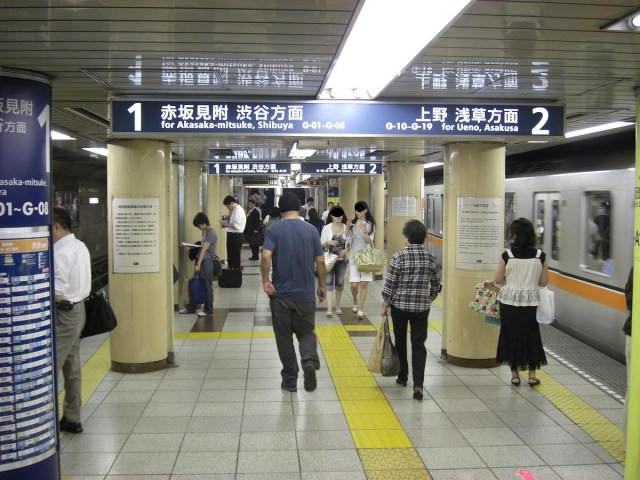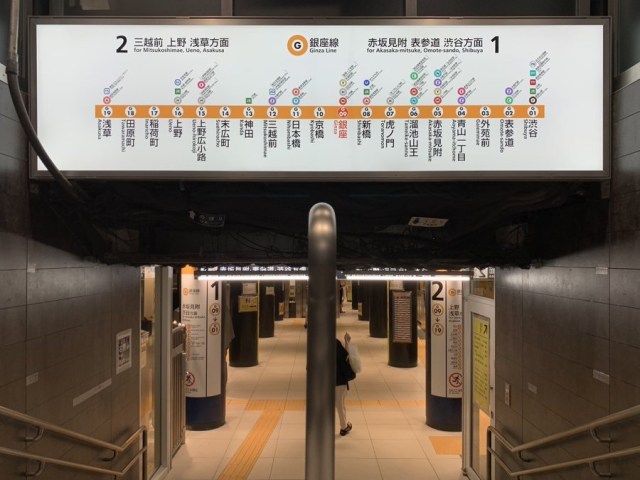
One day after it was pointed out on social media, it was fixed.
Japanese customer service has become famous around the world for its commitment to ensuring that diners, shoppers, and hotel guests have an enjoyable experience. But that dedication can be seen in the public transportation sector too, where rail operators strive to do all they can to make sure train and subway passengers arrive at their destination in a timely and pleasant manner.
Still, there’s always room for improvement, and on September 1 Japanese Twitter user @kiseshou pointed something out regarding the Tokyo Metro subway network’s Ginza Station. See if you can spot the problem in the photo below.
Ginza Station is in the middle of the Ginza Line, and if you’re headed down to the platform via the stairs shown in @kiseshou’s photo, Track 1 takes you towards Shibuya Station, and Track 2 is the one that heads to Asakusa Station, which are on completely opposite ends of downtown Tokyo. But while the which-track-goes-where information is clearly displayed on a sign above the stairs, the sign unfortunately makes it look like Track 1 is on the right and Track 2 is on the left, but that’s the opposite of where they really are (note the track numbers on the platform’s support pillars).
この前はじめて「逆方向の電車に乗る」というミスを銀座駅で犯してしまったんだけど、きょうやっと理由がわかった pic.twitter.com/IYNh31hv6e
— きせしょう (@kiseshou) September 1, 2020
The discrepancy is especially confusing because the misleading sign is what people will see first, and since they’ll see it just seconds before hopping on the train many people won’t stop to reconfirm their route on the platform pillars. “The other day, I got on a train going in the opposite direction I wanted to at Ginza Station,” tweeted @kiseshou, “and today [looking at this sign] I can see how that happened.”
Plenty of people who saw the tweet agreed that it’s a confusing way to guide subway users to where they need to go in order to get where they want to be. The very next morning after sending the tweet, though, @kiseshou was back in Ginza Station again, only this time…
…the sign had been corrected, and it now lists Track 1 on the left and Track 2 on the right, matching their actual positions on the platform when viewed from this angle. “Amazing! They fixed it in just one night,” said @kiseshou in an appreciative follow-up tweet. “It may just be a coincidence, but thank you, Tokyo Metro!”
すごい!
— きせしょう (@kiseshou) September 2, 2020
一晩で対応してる!!
たまたまかもしれないけど、東京メトロ(@tokyometro_info )さん ありがとうございます!! pic.twitter.com/WrsTMbigN2
For its part, the rail operator is indeed saying this is just a coincidence. The stairway in @kiseshou’s tweets is one of the few passages to the platform that’s oriented in the way it is, with most other access routes facing the opposite way. The company says that the incorrect signage had been installed, but that an employee had spotted the mistake earlier in the day on September 1, before @kiseshou posted the tweet.
That seems like an awfully big coincidence, but regardless of how the problem came to their attention, it’s nice to see that Tokyo Metro thought it was important enough to take care of ASAP, quickly putting up an ostensibly temporary tarp instead of doing nothing while waiting for a whole new sign. It’s definitely something passengers will be thankful for, since hopping on the wrong train and having to make a time-costly U-turn can be a stressful way to start your day if you’ve got an important meeting or test first thing in the morning, or to end it if it causes you to miss the last train of the night.
Sources: Twitter/@kiseshou, IT Media
Top image: Wikipedia/BetacommandBot (edited by SoraNews24)
Insert images: Twitter/@kiseshou (1, 2)
● Want to hear about SoraNews24’s latest articles as soon as they’re published? Follow us on Facebook and Twitter!



 Tokyo subway ”phantom station” reveals itself to passengers for first time in nearly 90 years
Tokyo subway ”phantom station” reveals itself to passengers for first time in nearly 90 years Enjoy hanami cherry blossom viewing on the Ginza Line Sakura Train in Tokyo
Enjoy hanami cherry blossom viewing on the Ginza Line Sakura Train in Tokyo Tokyo Metro adds platform display showing where least crowded parts of the next train will be
Tokyo Metro adds platform display showing where least crowded parts of the next train will be Turtle spotted riding Tokyo subway makes commuting in Japan’s busiest city adorable【Video】
Turtle spotted riding Tokyo subway makes commuting in Japan’s busiest city adorable【Video】 Tokyo subway bribes people with free noodles to get them to take earlier, non-rush hour trains
Tokyo subway bribes people with free noodles to get them to take earlier, non-rush hour trains Red light district sushi restaurant in Tokyo shows us just how wrong we were about it
Red light district sushi restaurant in Tokyo shows us just how wrong we were about it Starbucks Japan adds a Motto Frappuccino to the menu for a limited time
Starbucks Japan adds a Motto Frappuccino to the menu for a limited time Historical figures get manga makeovers from artists of Spy x Family, My Hero Academia and more
Historical figures get manga makeovers from artists of Spy x Family, My Hero Academia and more Sandwiches fit for a sumo served up in Osaka【Taste Test】
Sandwiches fit for a sumo served up in Osaka【Taste Test】 McDonald’s new Happy Meals offer up cute and practical Sanrio lifestyle goods
McDonald’s new Happy Meals offer up cute and practical Sanrio lifestyle goods Japan’s massive matcha parfait weighs 6 kilos, contains hidden surprises for anyone who eats it
Japan’s massive matcha parfait weighs 6 kilos, contains hidden surprises for anyone who eats it Haku is…Chihiro’s dead brother? Studio Ghibli fans blown away by Spirited Away theory
Haku is…Chihiro’s dead brother? Studio Ghibli fans blown away by Spirited Away theory Beautiful Red and Blue Star luxury trains set to be Japan’s new Hokkaido travel stars
Beautiful Red and Blue Star luxury trains set to be Japan’s new Hokkaido travel stars New private rooms on Tokaido Shinkansen change the way we travel from Tokyo to Kyoto
New private rooms on Tokaido Shinkansen change the way we travel from Tokyo to Kyoto Pokémon Sleep camping suite and guestrooms coming to Tokyo Hyatt along with giant Snorlax burgers
Pokémon Sleep camping suite and guestrooms coming to Tokyo Hyatt along with giant Snorlax burgers All-you-can-drink Starbucks and amazing views part of Tokyo’s new 170 meter-high sky lounge
All-you-can-drink Starbucks and amazing views part of Tokyo’s new 170 meter-high sky lounge More foreign tourists than ever before in history visited Japan last month
More foreign tourists than ever before in history visited Japan last month Japanese ramen restaurants under pressure from new yen banknotes
Japanese ramen restaurants under pressure from new yen banknotes French Fries Bread in Tokyo’s Shibuya becomes a hit on social media
French Fries Bread in Tokyo’s Shibuya becomes a hit on social media Studio Ghibli releases new action figures featuring Nausicaä of the Valley of the Wind characters
Studio Ghibli releases new action figures featuring Nausicaä of the Valley of the Wind characters Starbucks reopens at Shibuya Scramble Crossing with new look and design concept
Starbucks reopens at Shibuya Scramble Crossing with new look and design concept Studio Ghibli glasses cases let anime characters keep an eye on your spectacles
Studio Ghibli glasses cases let anime characters keep an eye on your spectacles Beautiful Ghibli sealing wax kits let you create accessories and elegant letter decorations【Pics】
Beautiful Ghibli sealing wax kits let you create accessories and elegant letter decorations【Pics】 Studio Ghibli releases Kiki’s Delivery Service chocolate cake pouches in Japan
Studio Ghibli releases Kiki’s Delivery Service chocolate cake pouches in Japan New definition of “Japanese whiskey” goes into effect to prevent fakes from fooling overseas buyers
New definition of “Japanese whiskey” goes into effect to prevent fakes from fooling overseas buyers Our Japanese reporter visits Costco in the U.S., finds super American and very Japanese things
Our Japanese reporter visits Costco in the U.S., finds super American and very Japanese things Studio Ghibli unveils Mother’s Day gift set that captures the love in My Neighbour Totoro
Studio Ghibli unveils Mother’s Day gift set that captures the love in My Neighbour Totoro New Japanese KitKat flavour stars Sanrio characters, including Hello Kitty
New Japanese KitKat flavour stars Sanrio characters, including Hello Kitty New Pokémon cakes let you eat your way through Pikachu and all the Eevee evolutions
New Pokémon cakes let you eat your way through Pikachu and all the Eevee evolutions Disney princesses get official manga makeovers for Manga Princess Cafe opening in Tokyo
Disney princesses get official manga makeovers for Manga Princess Cafe opening in Tokyo Sales of Japan’s most convenient train ticket/shopping payment cards suspended indefinitely
Sales of Japan’s most convenient train ticket/shopping payment cards suspended indefinitely Sold-out Studio Ghibli desktop humidifiers are back so Totoro can help you through the dry season
Sold-out Studio Ghibli desktop humidifiers are back so Totoro can help you through the dry season Japanese government to make first change to romanization spelling rules since the 1950s
Japanese government to make first change to romanization spelling rules since the 1950s Ghibli founders Toshio Suzuki and Hayao Miyazaki contribute to Japanese whisky Totoro label design
Ghibli founders Toshio Suzuki and Hayao Miyazaki contribute to Japanese whisky Totoro label design Doraemon found buried at sea as scene from 1993 anime becomes real life【Photos】
Doraemon found buried at sea as scene from 1993 anime becomes real life【Photos】 Tokyo’s most famous Starbucks is closed
Tokyo’s most famous Starbucks is closed One Piece characters’ nationalities revealed, but fans have mixed opinions
One Piece characters’ nationalities revealed, but fans have mixed opinions We asked a Uniqlo employee what four things we should buy and their suggestions didn’t disappoint
We asked a Uniqlo employee what four things we should buy and their suggestions didn’t disappoint Princesses, fruits, and blacksmiths: Study reveals the 30 most unusual family names in Japan
Princesses, fruits, and blacksmiths: Study reveals the 30 most unusual family names in Japan Awesomely adorable Pokémon subway trains start service in downtown Tokyo【Photos】
Awesomely adorable Pokémon subway trains start service in downtown Tokyo【Photos】 11 cheapest Tokyo neighborhoods to rent an apartment in show living here’s not an impossible dream
11 cheapest Tokyo neighborhoods to rent an apartment in show living here’s not an impossible dream We channel Sen from Ghibli’s Spirited Away and travel to a Japanese train station by the sea
We channel Sen from Ghibli’s Spirited Away and travel to a Japanese train station by the sea The hidden meaning of the U.S. Air Force’s “shake and fries” patch in Japan
The hidden meaning of the U.S. Air Force’s “shake and fries” patch in Japan Tokyo airport’s new train line to make getting into, out of the city easier for JR pass holders
Tokyo airport’s new train line to make getting into, out of the city easier for JR pass holders Tokyo Revengers anime/manga takes over Tokyo Station with dozens of character posters【Photos】
Tokyo Revengers anime/manga takes over Tokyo Station with dozens of character posters【Photos】 These are the 11 most crowded trains in Japan…and surprise! They’re all in the Tokyo area
These are the 11 most crowded trains in Japan…and surprise! They’re all in the Tokyo area Japan Railways to release new anti-groper smartphone app to help victims before chikan gets away
Japan Railways to release new anti-groper smartphone app to help victims before chikan gets away China’s first suspended railway looks like a panda soaring through the skies
China’s first suspended railway looks like a panda soaring through the skies Tokyo gets its first subway station ramen vending machine
Tokyo gets its first subway station ramen vending machine Tokyo’s Shibuya Station now sending trains on their way by playing the Dragon Quest theme 【Video】
Tokyo’s Shibuya Station now sending trains on their way by playing the Dragon Quest theme 【Video】 Breaking: Passengers stabbed on Japanese train in Tokyo
Breaking: Passengers stabbed on Japanese train in Tokyo “Passengers who don’t want to be groped, please use the rear train cars” announcement angers Japan
“Passengers who don’t want to be groped, please use the rear train cars” announcement angers Japan Google Maps sent us to a forbidden exit from one of Tokyo’s major subway stations
Google Maps sent us to a forbidden exit from one of Tokyo’s major subway stations What’s the real reason for the ‘floating’ 3-D signs at Haneda Airport?
What’s the real reason for the ‘floating’ 3-D signs at Haneda Airport?
Leave a Reply